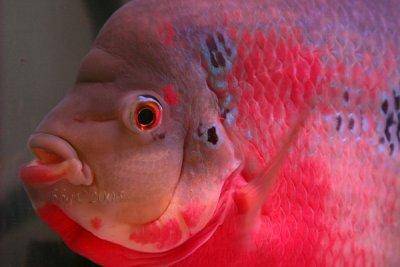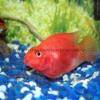Flowerhorn
Scientific name: Flowerhorn
Common name: N/A
Family: N/A
Usual size in fish tanks: 24 - 28 cm (9.45 - 11.02 inch)
014
Recommended pH range: 7 - 7.5
Recommended water hardness: 6 - 25°N (107.14 - 446.43ppm)
0°C 32°F30°C 86°F
Recommended temperature range: 25 - 30 °C (77 - 86°F)
The way how these fish reproduce: Spawning
Where the species comes from: Cultivated form / Hybrid
Temperament to its own species: aggressive/territorial
Temperament toward other fish species: aggressive/territorial
Usual place in the tank: Middle levels
Introduction
The Flowerhorn cichlid is a man-made hybrid species known for its vivid colors and distinct nuchal hump. It is not found in the wild and was created by crossing species like Amphilophus citrinellus and Cichlasoma trimaculatum. For this reason, it does not have an official scientific name (we refer to it as 'Flowerhorn' in our internal records). Flowerhorns were originally bred in Central America and have since gained popularity worldwide due to their unique appearance and lively behavior. While they are hardy and can adapt to various water conditions, they are also aggressive and territorial, making them best suited for experienced aquarists.
Aquarium Setup
The Flowerhorn cichlid requires a large, spacious aquarium to thrive. A single adult Flowerhorn needs at least 300 liters (79.25 US gallons) of water, with additional space if you plan to house more fish. It’s important to provide enough swimming room and open space while offering territories for the fish to establish.
Substrate and Decor: While some Flowerhorns are kept in tanks with no substrate or decor, it is beneficial to include coarse gravel or larger-sized substrates to accommodate their digging habits. Avoid fine substrates that could be accidentally ingested. Due to their tendency to disturb the substrate, live plants are not ideal, but artificial plants or sturdy décor like terracotta pots or rocks can provide hiding spots and reduce stress.
Filtration and Water Changes: Flowerhorns are high waste producers, so a powerful filtration system is essential to maintain water quality. Regular water changes are also necessary, with 25-30% weekly water changes recommended for smaller tanks. In larger tanks (300 liters or more), a 15-20% weekly water change is sufficient to keep water quality stable.
Lighting: Flowerhorns do not require special lighting conditions, but moderate lighting is ideal. They can be sensitive to sudden changes in light, so it’s best to avoid overly bright lights, which could stress the fish.
Water Parameters: Maintain the water temperature between 25-30°C (77-86°F), with a pH level between 7 and 7.5, and a water hardness (dGH) between 6-25°N. Keeping the water parameters stable is key to ensuring the fish’s long-term health.
Feeding and Diet
Flowerhorn cichlids are omnivores with a voracious appetite, but their diet should be carefully monitored to avoid overfeeding. Their diet can consist of high-quality pellets designed for cichlids, live or frozen foods like earthworms, bloodworms, and small feeder fish, as well as vegetables like peas.
Feeding Tips:
- Feed them twice a day, and ensure that all uneaten food is removed after 15 minutes to maintain water quality.
- Use Flowerhorn-specific food for enhanced coloration and growth.
- Supplement their diet with live or frozen foods like snails and shrimp for protein.
While Flowerhorns can tolerate a variety of foods, avoid feeding them too much fatty or rich food (like beef heart), as this can lead to digestive problems. A well-balanced diet is important to maintain their vivid coloration and health.
Behavior and Tank Mates
Flowerhorn cichlids are aggressive and territorial, particularly males. While juveniles may be relatively peaceful, their aggression increases as they mature. It’s best to house Flowerhorns as single specimens in a tank, especially if you don’t have experience handling aggressive fish. If you decide to keep them with other fish, ensure that the tank is large enough and there are plenty of hiding places and territories.
Managing Aggression:
Flowerhorns can sometimes coexist with other large, peaceful bottom-dwellers like plecos or robust cichlids, but only in very large tanks with sufficient hiding spots. The tank should have enough territories to reduce stress and limit potential conflicts. Placing dividers or using upturned pots to create separate spaces can help in managing territorial behavior.
Breeding
Flowerhorn cichlids are relatively easy to breed in captivity. To encourage breeding, increase the water temperature to around 30°C (86°F) and ensure the tank has flat rocks or smooth surfaces for spawning. When ready to breed, the pair will hover near the heater or chosen spawning site.
Once the female lays her eggs, the male will fertilize them, and the pair will protect the eggs. The eggs typically hatch after 3-4 days, and the fry become free-swimming a few days later. At this point, they can be fed newly hatched brine shrimp or powdered fry food.
Keep an eye on the male, as aggression between the pair can occur after spawning. If aggression becomes an issue, use a tank divider to protect both fish.
Health and Common Issues
Flowerhorn cichlids are generally hardy but can be prone to certain health problems if not cared for properly. One common issue is swim bladder disorder, which can cause the fish to lose its balance and swim upside down or sideways. This can be caused by overfeeding, so it’s important to monitor their diet carefully.
They are also susceptible to common cichlid diseases like ich and hole-in-the-head disease. Maintaining pristine water conditions, performing regular water changes, and providing a varied diet can help prevent these issues. If you notice signs of illness, such as white spots or disorientation, treat the tank immediately with appropriate medications.
Questions and Answers
-
Why can’t my Flowerhorn tell which way is up?
It could be a common case of swim bladder disorder, which affects the fish’s ability to maintain balance. Adjust their diet and consult with a vet if the condition persists.
-
What types of fish can I keep with Flowerhorns?
Due to their aggressive nature, it is best to keep them as the only fish in the tank. If you have a large enough aquarium with hiding spots, you may be able to house large, tough fish like plecos or other large cichlids with them.
-
When do Flowerhorns start growing their hump?
The nuchal hump, or "kok," usually becomes more prominent as the fish matures, typically developing after a year of age, with males often showing larger humps.
Special thanks goes to Bien Gutierrez, Kevin and Remy Tran who have allowed us to use his picture.
























































 Blood
Blood